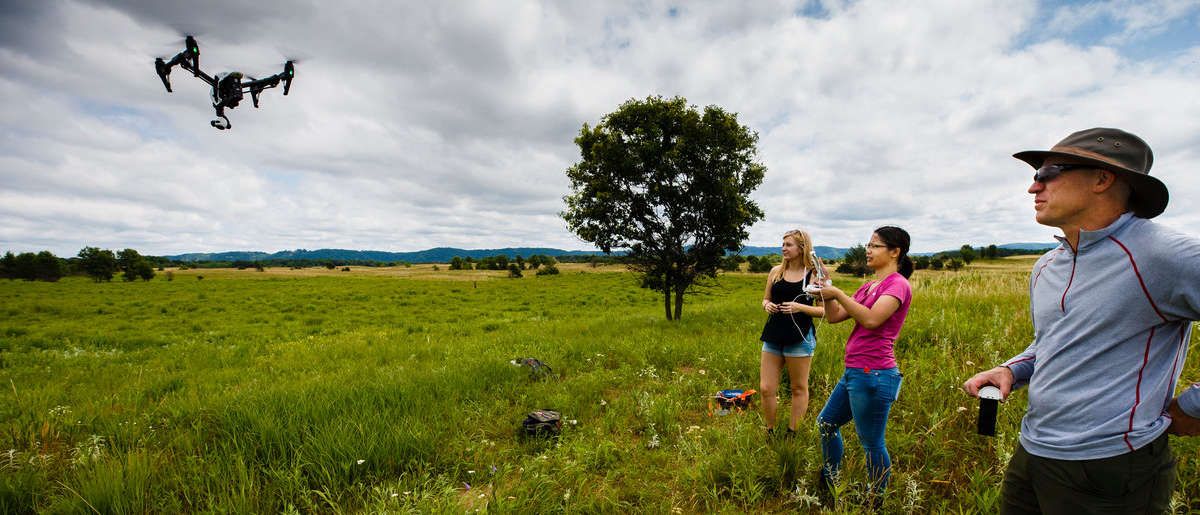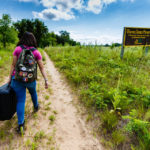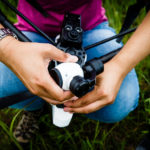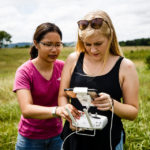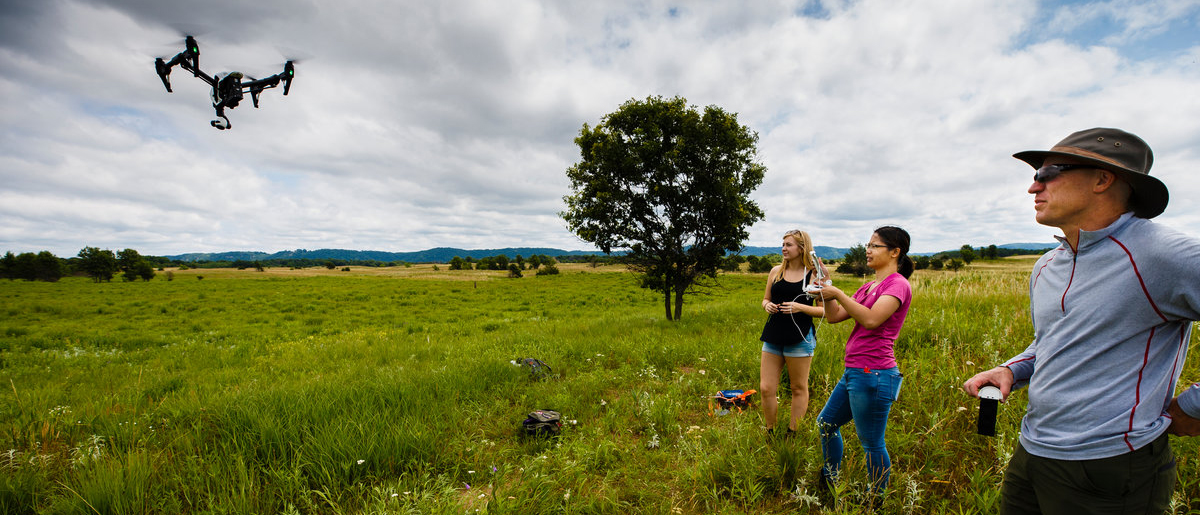
Alice Ready (left), Emma Rinn and Prof. Paul Lorah upload a survey route to their DJI Inspire drone before sending it out to survey the Weaver Dunes. (Photos by Mike Ekern ’02)
Juniors Alice Ready and Emma Rinn trekked through the tall prairie grass alongside Dr. Paul Lorah, carrying what appeared to be hefty plastic suitcases. It was a warm and sunny summer day, if a little overcast – a perfect day for hikers and picnickers to enjoy the Weaver Dunes Preserve.
The preserve sprawls across 819 acres in Wabasha County, near Kellogg, Minnesota. Just west of the Mississippi River, the Weaver Dunes Preserve was acquired by The Nature Conservancy in 1980 and features sand dunes that reach up to 30 feet.
Ready and Rinn unpacked their bags, assembled their equipment and looked skyward. With well-developed dexterity, they began to fly their drones.
Throughout the summer, Ready and Rinn returned several times to fly a pair of drones. They are researching how aerial images can best be used to gather data and support the work of the Minnesota Nature Conservancy, a nonprofit that protects ecologically important lands and waters, such as the Weaver Dunes Preserve.
“They’re in a cool position to do work that other people aren’t doing,” said Lorah, associate professor in the Geography and Environmental Studies Department in the College of Arts and Sciences and the pair’s mentor.
Ready and Rinn also were setting a foundation for future geography and environmental studies students: If all goes according to plan, St. Thomas students will continue to provide information to The Nature Conservancy for many years to come.
Finding community
Ready and Rinn, of La Crescent and Northfield, Minnesota, respectively, connected with Lorah when they joined the Sustainability Living Learning Community (LLC) during its first year on campus.
Through this community (there are nine total) first-year students live together in Dowling or Brady Hall and explore sustainable human environment systems through multidisciplinary courses. They develop skills necessary to write grants, conduct research and effectively engage with community partners on projects that promote both environmental and social well-being.
Both Ready and Rinn were interested in environmental issues and found the learning community invaluable in meeting others with similar interests, which was one of Rinn’s goals in joining.
“I met Alice, and we work really well together,” she said.
Ready added that having a close relationship with Lorah, as well as community partners such as The Nature Conservancy, helped her grow. She moved from a general interest in the environment to deciding on a major and having a realistic sense of what work she could do after graduating.
“Having close relationships with the community partner, you can see what actual professionals are doing,” Ready said. “That’s what I’m getting the most: actual real-world experience.”
“A lot of it is good networking,” Rinn added. “You really feel like you’re an adult when you’re doing this, because they treat you like a peer.”
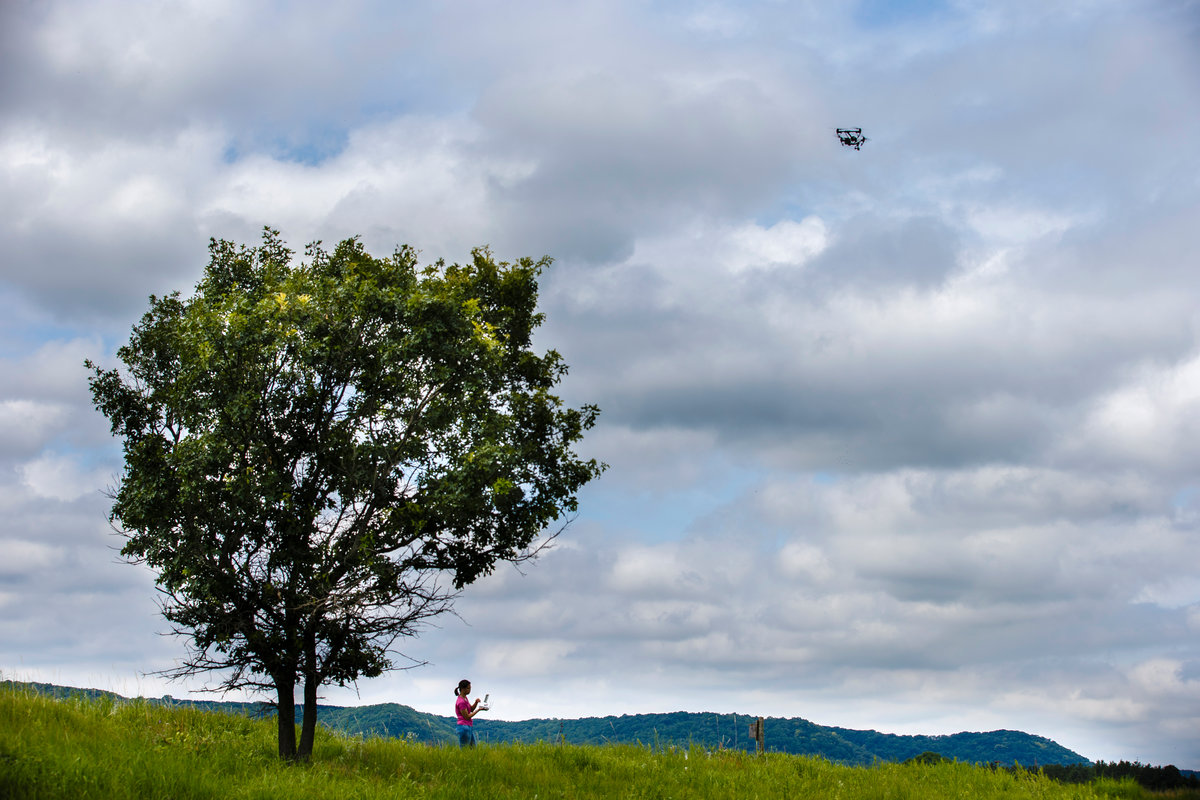
Rinn flies the DJI Inspire toward its survey area.
Learning drone technology
Rinn and Ready approached Lorah after their first year about research opportunities and applied for St. Thomas-funded Sustainability Scholars Grants, which allowed them to do their own research. Using two drones, Rinn and Ready used technology in ways that Lorah described as “groundbreaking” because of a lack of literature on drone techniques.
Rinn’s focus is on best practices for flying the drones, setting a flight path while the drone takes photos along the way. Those images then are stitched together. A lot has to be taken into account during this process, and Rinn and Ready even had to become licensed through the Federal Aviation Administration to fly the drones.
“We designed study areas and discovered the best way to take a picture, at what speed, at what height for the best resolution, the best options,” Rinn said.
A lot of that meant just good, old-fashioned trial and error.
“The drones and software we used were both relatively new, so we made three mistakes for everything we learned, but we improved each week, which is great,” Lorah said.
One example of their work was trying to render 3-D images of trees in order to estimate their volume. Why? Currently, large corporations can pay for carbon credits; they invest in a large area of land to negate their carbon emissions. Rinn and Ready have theorized if they can calculate the volume of a tree, carbon credits can be estimated for a smaller plot of land. That would allow smaller companies, such as coffee shops, opportunities that are currently too expensive to consider.
Meanwhile, Ready mapped out a flight path several times over the summer so students can see, over time, how an area changes after a prairie burn, which will tell The Nature Conservancy how effective that process is. To maintain the prairie, the preserve has been divided into several units, each of which is burned every four years or so. The fire helps cycle nutrients, reduces invasive plants, maintains grasslands for wildlife and benefits pollinators.
“Each year we’re going to have insights into how these landscapes are recovering,” Lorah said.
Once they have their respected parts perfected, Rinn and Ready will create a lesson plan Lorah can use for future first-year students. St. Thomas students will fly the same study areas year after year to analyze landscape changes and the effectiveness of conservation efforts.
Changing the world
Lorah emphasized the Geography Department tries to make sure its majors do interesting research projects. This project is representative of that goal, with its combination of a high-quality community partner, learning new technology and a chance to make an immediate and lasting impact.
“We’re giving them the skills, background knowledge and insights to make a difference now as undergrads,” Lorah said. “They’re going to make a difference for the conservancy.”
As two students who entered the field because of a love of the environment, it’s no surprise having an impact is one of the perks of Ready and Rinn’s work.
“I want to be in a career where I make a difference,” Ready said. “For me, that comes out through environmental studies and environmental issues.”
“I want to change the world,” Rinn said. “If we can figure out this mapping volume, that would be groundbreaking, because no one else is doing this. That might just turn into my career.”
Read more from St. Thomas magazine.
